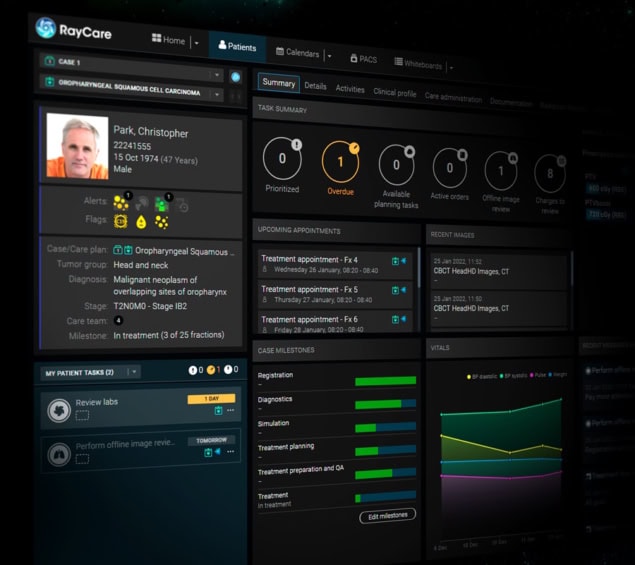The RayCare OIS helps clinics increase the efficiency of providing quality care for cancer patients, now and into the future

The oncology information system (OIS) lies at the heart of all cancer care, managing the entire clinical pathway – from patient registration, to treatment scheduling and delivery, to follow-up. The software revolution has transformed cancer care from paper-based charts and records to today’s fully digitized processes. But an OIS can do so much more: it can collect data to analyse and learn from, automate tasks and data processing, and intuitively guide users to the information that they need.
A case in point is RayCare, the OIS from oncology software specialist RaySearch Laboratories. RayCare is now used in clinics across three continents, in many cases supporting the entire chain of cancer patient management and in others, coexisting with the hospital information system or working alongside another OIS.
First launched in 2017, RayCare was built from the ground up with the users’ needs in mind. “RayCare originated as a customer need,” explains RayCare chief functionality owner Eeva-Liisa Karjalainen. “We already had our RayStation treatment planning system, which was very well received in terms of its speed and quality, and some of our customers reached out to ask why we didn’t have an OIS software as well. In parallel, we saw a need to combine the OIS and the planning software to achieve important radiotherapy goals such as efficient management of adaptive treatments.”
In response, the company set up a clinical advisory board with various hospitals and spent hundreds of hours working with nine clinics worldwide to define not just how an OIS should perform today, but what they’d like it to do in the future and how to achieve that. The aim was to not build something that already existed, but to create a system that would be useful for the future of cancer care.

At the ESTRO 2024 meeting, the company is launching RayCare 2024A, a major release that will offer a range of top-level enhancements requested by users. This includes a completely new workspace to design and manage treatment courses and scheduling from RayCare. “This brings the advantage that, together with digital workflow support and the integration with RayStation, we can make the whole treatment management process more user-friendly and more efficient,” Karjalainen explains.
And herein lies the key attribute of RayCare: its ability to increase efficiency while maintaining or improving the quality of patient care – a pressing task for cancer clinics worldwide. With an ageing population, hospitals face the challenge of providing high-quality cancer care to an increasing number of patients with a static level of resources. RayCare can help balance available resources against this increasing need for care.
Saving time through automation
RayCare’s “active workflows” provide support for the activities required throughout the entire patient pathway. Unlike prior systems, in which users had to check off finished tasks from a list and inform the next person in the workflow, RayCare actively monitors everything that happens within the system. When a task has been completed, the software automatically opens up the next task in the workflow, assigns that task to the responsible user and informs them that their next step is ready to perform.
This approach reduces lead times between activities and minimizes time spent on manual interactions. Critically, the active workflows also provide a vital safety check, by ensuring that no tasks are forgotten.
To increase efficiency further, RayCare incorporates a wide range of inherent automation features. In general, all data that should be available throughout the RaySearch systems are automatically shared and available where the user needs them, to minimize errors and the need for manual work. For instance, after a planning CT is acquired and received in RayCare, it automatically becomes available within the treatment planning system.

There’s also support for automation by use of scripting that allows users to easily configure the software to run specified actions automatically. A typical use case is to instigate generation of a treatment plan in RayStation directly from RayCare, getting it ready for a physician to review without needing any manual interaction.
“A recent example from one of our customers is the performing of scripted quality controls of a treatment plan, checking off a multitude of parameters that were previously checked manually and only pushing the plan onto an additional review if any of those checks failed,” says Karjalainen. “If the plan is within all of the quality measures, no one needs to do anything and it can go straight for approval. Otherwise it can be passed back to another staff member for review.”
Karjalainen points out that while it’s possible to use advances in radiotherapy hardware to treat more patients, for example by delivering radiation faster to reduce fraction times, the big efficiency savings will inevitably come from the automation and organizational support that software such as RayCare brings. “We see the software opportunity as a game changer,” she adds.
Patient-centred approach
Ultimately, RayCare is designed to provide a patient-centred approach based on the concept of a single oncology workflow. Patients often require more than one treatment modality in their cancer care, including surgery or medical oncology as well as radiotherapy. RayCare aims to ensure that staff in all of these disciplines can access the same patient data from one system.
“We want to bring all of these users to RayCare, to centre them around the patient and not have to transport information between different systems or institutions, which is more error prone and also shifts more responsibility to the patient,” Karjalainen explains.
The RayCare architecture already incorporates the framework to enable this type of comprehensive cancer care. And in the future, it will offer specific features such as scheduling for chemotherapy and dedicated workspaces to manage medical oncology and surgical information. This approach should enable better cross-disciplinary communication and reduce the burden on both the hospital and the patient.
“In the long term, the hope is that all activities related to oncology care would be conducted using RayCare. It will not only be the software for the radiotherapy department, but also the software for the surgery and medical oncology departments. Within one system, you could review the toxicities, the data, the outcomes and get a cohesive view on the patient’s history,” says Karjalainen. “At the same time, we are strong advocates for enabling clinics to select the best software or hardware for their clinical needs, independent of vendor. RayCare is designed to communicate with other hospital systems as one of the building blocks of the ecosystem.”
RaySearch’s commitment to supporting open interfaces and open competition is reflected in the company’s co-founding last year of the organization UniteRT, a collaboration of radiation therapy technology vendors that share the mission of complete freedom of choice for the customers.

Machine-learning innovation in RayStation: prioritizing speed, automation, efficiency
Echoing this strong focus on supporting future technologies, RaySearch is also working on the automation of online adaptive radiotherapy, a longstanding and important clinical goal for the radiotherapy community. Online adaptive radiotherapy – in which a treatment plan is adapted to the patient’s current anatomy during the course of their treatment – requires the ability to perform extremely fast planning and replanning.
ESTRO 2024 will see the company present some of the first pieces of this project, the newly reworked fast replanning in RayStation. And in one of the next major software releases, this capability will be integrated into the RayCare software. “Truly efficient online adaptive radiotherapy is something that I’m really looking forward to becoming a reality in our RayCare clinics,” says Karjalainen.




